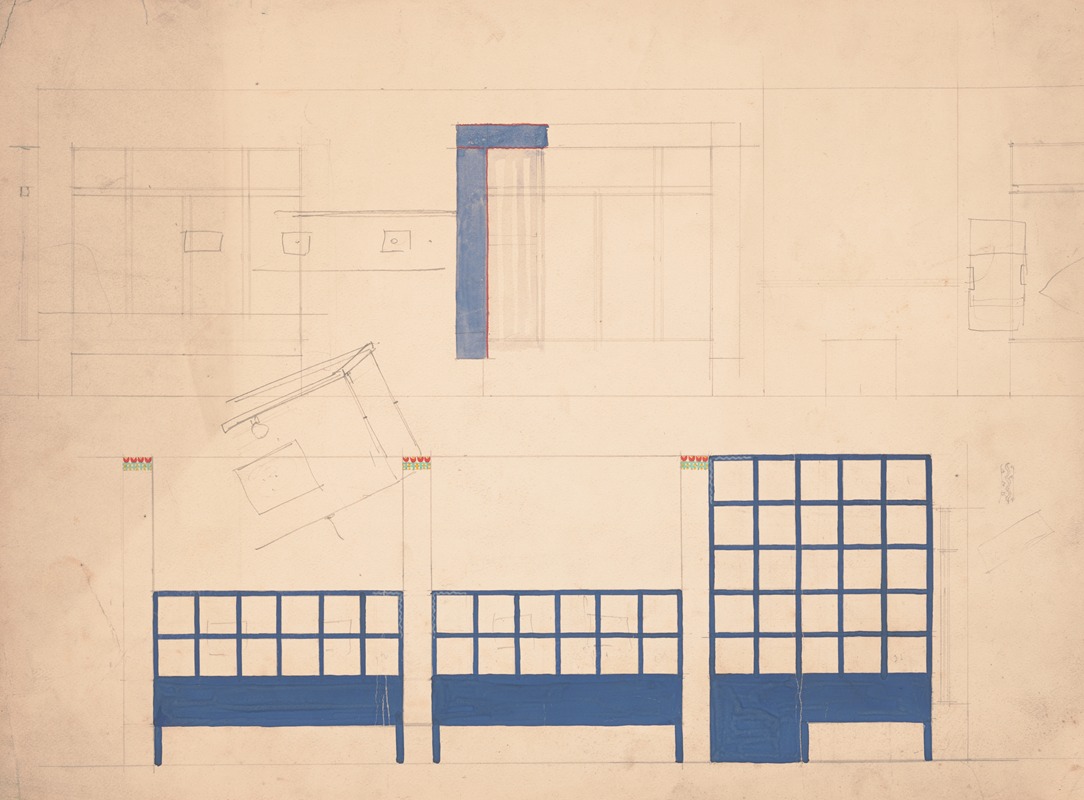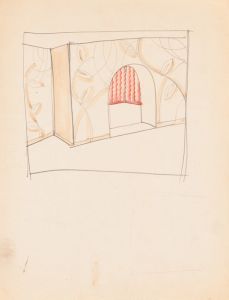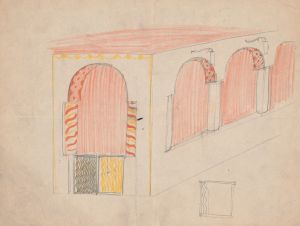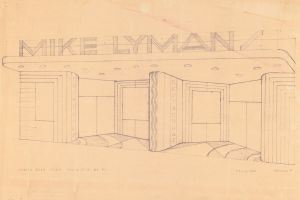
Designs for unidentified restaurant interior, possibly Elysée restaurant, 1 East 56th St., New York, NY.] [Drawing of restaurant details
A hand-painted replica of Winold Reiss’s masterpiece Designs for unidentified restaurant interior, possibly Elysée restaurant, 1 East 56th St., New York, NY.] [Drawing of restaurant details, meticulously crafted by professional artists to capture the true essence of the original. Each piece is created with museum-quality canvas and rare mineral pigments, carefully painted by experienced artists with delicate brushstrokes and rich, layered colors to perfectly recreate the texture of the original artwork. Unlike machine-printed reproductions, this hand-painted version brings the painting to life, infused with the artist’s emotions and skill in every stroke. Whether for personal collection or home decoration, it instantly elevates the artistic atmosphere of any space.
Winold Reiss was a German-American artist and designer known for his work in interior design and portraiture. Born in 1886 in Karlsruhe, Germany, Reiss immigrated to the United States in 1913, where he became a prominent figure in the American art scene. His work often combined elements of European modernism with American themes, and he was particularly noted for his vibrant use of color and innovative design techniques.
One of Reiss's notable contributions to the field of interior design was his work on restaurant interiors. Among his projects was a series of designs for an unidentified restaurant interior, which some sources suggest might have been for the Elysée restaurant located at 1 East 56th Street in New York City. However, there is no definitive evidence to confirm this attribution, and the exact location and client for these designs remain uncertain.
Reiss's designs for restaurant interiors were characterized by their bold use of color and geometric patterns, reflecting the influence of the Art Deco movement, which was popular during the early to mid-20th century. His work often incorporated elements such as murals, stained glass, and custom furniture, creating immersive environments that were both functional and aesthetically striking.
In addition to his work in interior design, Winold Reiss was also renowned for his portraiture, particularly his depictions of Native Americans and African Americans. His portraits were celebrated for their sensitivity and attention to detail, capturing the individuality and dignity of his subjects. Reiss's work in this area was groundbreaking, as it challenged the stereotypical representations of these communities that were prevalent at the time.
Throughout his career, Reiss maintained a commitment to integrating art into everyday life, believing that art should be accessible and enriching for all people. His designs for public spaces, including restaurants, were an extension of this philosophy, as he sought to create environments that were both beautiful and welcoming.
Reiss's legacy in the field of design and art is significant, as he helped to shape the aesthetic landscape of early 20th-century America. His work continues to be studied and appreciated for its innovative approach and cultural significance. Despite the lack of complete information regarding some of his projects, such as the unidentified restaurant interior, Reiss's influence on the world of design remains undeniable.
In summary, while specific details about the designs for the unidentified restaurant interior remain elusive, Winold Reiss's contributions to art and design are well-documented and celebrated. His work exemplifies a unique blend of artistic vision and cultural sensitivity, leaving a lasting impact on the fields of interior design and portraiture.





![Designs for Hess Brothers Restaurant, Allentown, PA.] [Dinner menu](/imgs/249243/s/winold-reiss-designs-for-hess-brothers-restaurant-allentown-pa-dinner-menu-2d87eef3.jpg)
![Graphic designs for Fortune magazine.] [Study for cover with telephone lines spanning the globe](/imgs/249256/s/winold-reiss-graphic-designs-for-fortune-magazine-study-for-cover-with-telephone-lines-spanning-the-globe-766a580f.jpg)
![[Design for the Lentheric Salon, Fifth Ave. & 58th St., Savoy-Plaza Hotel, New York, NY.] [Perspective rendering](/imgs/249263/s/winold-reiss-design-for-the-lentheric-salon-fifth-ave-58th-st-savoyplaza-hotel-new-york-ny-perspective-rendering-e749987f.jpg)
![Design for fine art print, ‘The Mad Dancer’.] [Woodcut print](/imgs/249287/s/winold-reiss-design-for-fine-art-print-the-mad-dancer-woodcut-print-17d9defa.jpg)
![Design for Longchamps Restaurant, 79th St., New York, NY.] [Proposed treatment for front of restaurant](/imgs/249289/s/winold-reiss-design-for-longchamps-restaurant-79th-st-new-york-ny-proposed-treatment-for-front-of-restaurant-83a4c86c.jpg)
![esigns and photographs for alterations to St. James Bar Restaurant, W. 181st St. and Broadway, New York, NY.] [Plan for restaurant layout of booths and tables](/imgs/249342/s/winold-reiss-esigns-and-photographs-for-alterations-to-st-james-bar-restaurant-w-181st-st-and-broadway-new-york-ny-plan-for-restaurant-layout-of-booths-and-tables-65bfed35.jpg)

![Designs for theater with black-framed proscenium and boldly colored settings.] [Study for stage light wall decoration, possibly for Caf ̌Crillon](/imgs/249423/s/winold-reiss-designs-for-theater-with-blackframed-proscenium-and-boldly-colored-settings-study-for-stage-light-wall-decoration-possibly-for-caf-crillon-5f9976e0.jpg)
![Drawings for proposed decorations of Mike Lyman’s Restaurant, 424 W. Sixth St., Los Angeles, CA.] [Drawing #10, Scheme 1; Color scheme for ceiling – main dining room](/imgs/249426/s/winold-reiss-drawings-for-proposed-decorations-of-mike-lymans-restaurant-424-w-sixth-st-los-angeles-ca-drawing-10-scheme-1-color-scheme-for-ceiling-main-dining-room-6113fb5a.jpg)
![Miscellaneous small sketches for inlaid table tops.] [Design with female face and cocktail beverage](/imgs/249434/s/winold-reiss-miscellaneous-small-sketches-for-inlaid-table-tops-design-with-female-face-and-cocktail-beverage-70c0c6ed.jpg)


